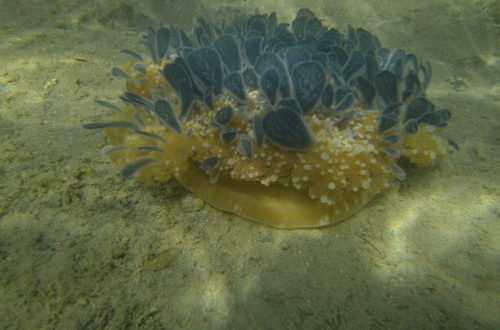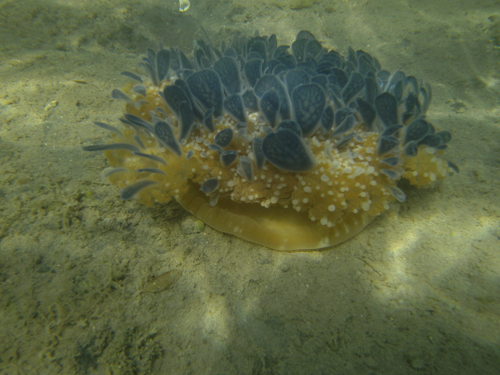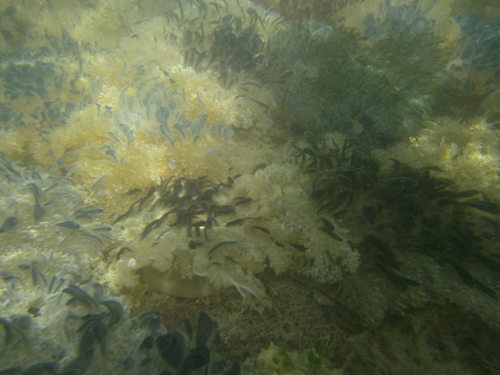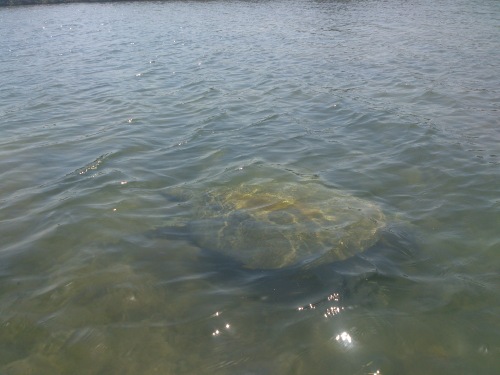Arambada Lake: India’s Jellyfish Lake
By
S Goutham
Project Lead,
West Coast Marine Conservation Project
Recently, Wildlife Trust of India’s (WTI) researchers stumbled upon something unique! It was during their routine field visit to a small town named Armabada in Gujarat, that the research team noticed a few small boondocks. A bridge separated the water body from the Gulf of Kutch, with the only water exchange happening through a canal below the bridge.
Much intrigued at what could be in this ‘Lake’ a couple of WTI marine biologists took snorkeling kits armed with an underwater camera and started to shovel the secrets of this ‘Lake’. At the first dip was close to the road bridge, they were surprised to find huge mangrove snappers and silver biddies curiously coming close to them and nibbling their skin.
As they snorkeled further, they realised that the bottom was matted with algae with something pulsating around them. A closer look revealed that it was jellyfish. Further down the lake it was as if the whole bottom was carpeted with jellyfish. It was a beautiful sight and the researchers had never encountered such big bloom of jellyfish before! Back at the field camp they identified the jellyfish as ‘upside down jellyfish’ (Cassiopea sp).
“This kind of jellyfish is found mostly in intertidal sand or mud flats, shallow lagoons, and mangrove forests. They are called so because they are found upside down on the sea bed unlike others. They position themselves on their bottom side to receive maximum sunlight as they harbor photosynthetic algae called Zooxanthellae, which have a symbiotic relationship with jellyfish similar to corals”, explains marine biologist S. Goutham, WTI.
“These jellyfish require carbon from the zooxanthellae but this does not meet their daily metabolic needs. The stinging cells attached on the umbrella like body called nematocysts assist in capturing prey. The jellyfish also filter feeds and absorbs dissolved nutrients from seawater as supplement food”, added Dr Deepak Samuel, marine biologist, specializing on invertebrates.
Another unique feature of the lake was that these jellyfish were present all around the year unlike other places where reports have been seasonal.
At the moment, many reasons are being speculated for this jellyfish bloom. Some are that, the species is usually found in places where the wave action is less and as there is less or no wave action in the lake, it could have created nutrient imbalance which promote jellyfish bloom, as flushing is very minimal. Certain species of upside-down jellyfish is used as potential bio-indicator for phosphate availability in low nutrient environments (Todd et al., 2006) and the predation could also be less in this lake which could be a reason for the bloom. “These jellyfish are generally found in groups and masses” , commented S. Subburaman, marine biologist, WTI.
Further interaction with an experienced local fisherman, Sultan Bhai, revealed that a group of turtles have also taken residence in the same lake. Sultan Bhai added “When the bridge was built a decade ago, it separated this small extension of the Gulf and a small population of turtles was trapped”. As the canal head was too narrow, the bigger turtles could not migrate back to the sea.
A small survey by WTI was conducted in the lake to assess the population of these stranded turtles. It was found that 20-30 turtles are residing in this lake. During the survey a few huge turtles were seen trying to enter the canals but were unsuccessful. “A few places in the lake had sea grass which could have been the answer to the survival of these turtles. Also, further down there a population of green turtle preying on upside-down jellyfish which also could have contributed to its survival”, explained Prof. BC Choudhury, Principal Invigilator and Senior Advisor, aquatic programs, WTI. Dr Choudhary is also the author of Marine Turtles of India. He further added, “These turtles should be rescued as they do not have any future in this lake as breeding is impossible. As many sizes and classes were encountered during the survey, we are not sure if new turtles are entering this lake occasionally”.
“A study on these turtles has been suggested by Prof. BC Choudhury as it might be easy to catch and satellite tag them, unlike the ones in the open sea. Further collaboration and funding options are being explored to undertake this feat to rescue and study the turtles and as well as the chances for this lake being the jellyfish Lake of India” commented Dr. Rahul Kaul, Chief Ecologist, WTI.
Wildlife Trust of India has been working in Mithapur coral reef and whale shark conservation in partnership with Tata Chemicals Limited and Gujarat Forest Department. This could be an expansion to conservation of marine turtles and jellyfish as well.
The world renowned jellyfish lake is located on Eil Malk Island, Palau, Trust Territory of USA. Arambada lake, Gujarat could be the jellyfish lake of India!
_______________________________________________________________
Ref: Todd, B.,D. Thornhill, W. Fitt. 2006. Patterns of inorganic phosphate intake in Cassiopea xamachana: A bioindicator: Marine Pollution Bulleting, 52/5: 515-521.
For further reading:
http://en.wikipedia.org/wiki/Cassiopea_andromeda
http://oceana.org/en/explore/marine-wildlife/upside-down-jellyfish
http://animaldiversity.ummz.umich.edu/accounts/Cassiopea_xamachana/












